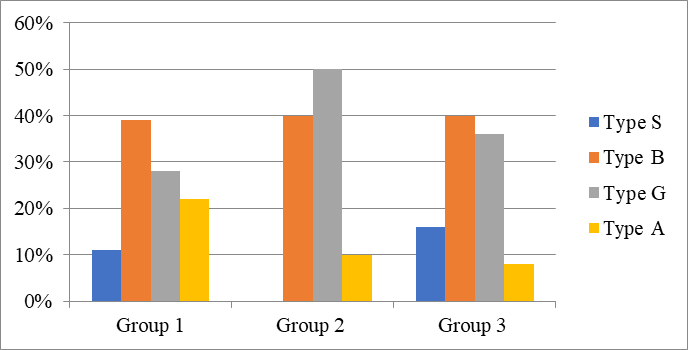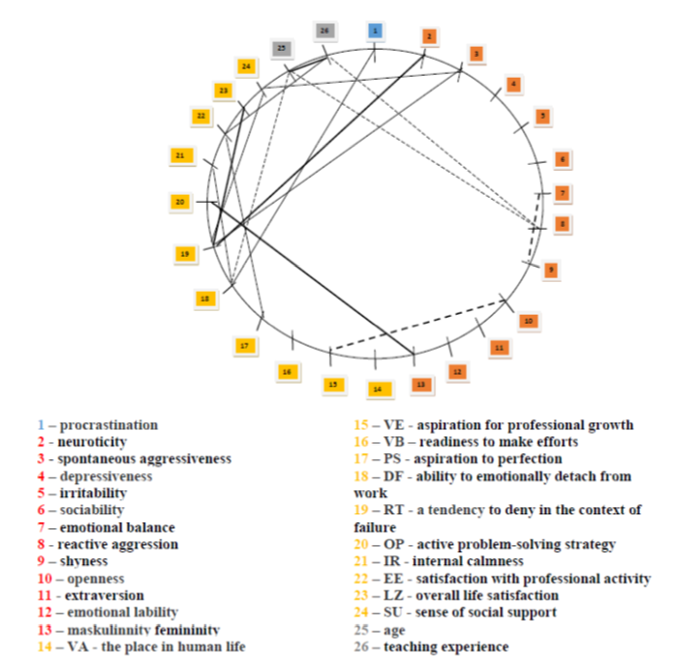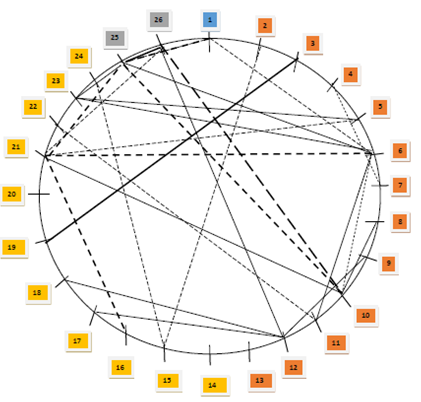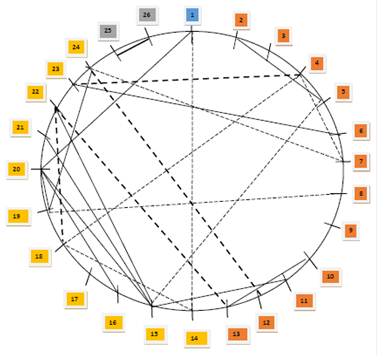Abstract
The importance of the problem relates to the analysis of teaching activity in correlation with a mode of behaviour in the context of imposed professional requirements. The purpose of the article is to study the interrelationship between procrastination and teachers’ personal qualities and professional requirements imposed on them depending on their teaching experience. The Pearson’s correlation analysis (the Pearson’s correlation coefficient) is the main method used to investigate the aforementioned problem. The correlation analysis shows that in case of teachers having 7 years of work experience, procrastination is related to professional requirements. This fact is proved by a direct correlation between the “procrastination index” and the index of “emotional detachment from work”. According to the correlation analysis of teachers having 8-15 years of work experience, the “procrastination” index has inverse correlations with the “sociability”, “age”, and “teaching experience” indexes. The rate of procrastination in teachers having 16-23 years of work experience is directly linked to the index of “active problem-solving strategy” and has an inverse correlation with the index of “personal priority”. In general, procrastination in teachers is correlated with professional requirements and personal factors that cause detachment from work and thus result in overloading and procrastination of certain tasks. Besides, emotional instability leads to tension and reluctance to meet professional requirements and perform relevant teaching tasks resulting in further procrastination. It proves that professional activity influences a general psychological well-being of a teacher, and the quality of performed teaching tasks.
Keywords: Procrastinationpersonal factorprofessional requirementsteaching experience
Introduction
Over the past two decades, many countries in the world have faced new demands and changes in the educational environment (Ballet & Kelchtermans, 2009). New tasks assigned to the modern education call for training the new type of teachers capable of developing their own pedagogical system that is consistent with the ideas of the general cultural development of humans (Bengardt, Vetkhova & Dmitriyeva, 2016). Therefore, to date, the school imposes strict demands on all aspects of teaching activity, in particular, knowledge, pedagogical skills, methods, and personal characteristics. A teacher at the general education school should be able to plan independently, prepare and organize activity-oriented classes in special disciplines, and evaluate them. At the same time, the teacher should choose training methods and technical tools, adapt them according to a specific situation and be able to use in practice (Edgorova, 2012). In addition, the teacher should have a high level of academic knowledge in the chosen specialty, understand general pedagogical, methodological and technological aspects of teaching, be able to communicate with students in a gentle and polite manner in terms of subject-to-subject relationship, and interact with colleagues and superior structures on the basis of friendship, cooperation, and mutual assistance (Dolgova, Miller, & Motorina, 2015).
In the context of these principles, we believe that studying the factors that impede psychological well-being in the professional environment of a teacher is a matter of special importance. The teacher who meets the mentioned professional requirements may later experience personal detachment from performed activities and procrastinate. For this reason, high living standards and mental health are important conditions that guarantee mental well-being of a teacher (Pavlova, 2014).
Problem Statement
Psychological safety of all subjects of the educational process is a key problem of the modern educational system. According to Vasilievskaya (2011), teachers refer to a professional group that has extremely low rates of physical and mental health. These rates decrease in direct proportion to the years of teaching experience at school. The quality of professional training depends on the effectiveness of the educational system that keeps changing and reflecting the new demands of society conditioned by the development of science and technology (Guseva & Mayatskaya, 2012). Due to the increased requirements imposed on the educational system and a considerable workload of teachers, administration of educational institutions is not always able to pay due attention to the mentioned aspects (Ivanova et al, 2015). Attitude to work is a variable that is important in assessing personal ability to work. Effective behavior of an employee depends on professional skills and competences specific to a certain type of work, significant personal qualities, needs, values, and attitudes to various aspects of organization and professional activity (Bentea, 2015). Teacher’s individual style is the personal system of approaches and methods aimed at solving professional problems in the changing environment, that reflects the requirements of the modern society to the teacher's personality (Snigereva, 2011). The key competencies of teachers, especially in primary schools, include not only basic knowledge of education, but personal characteristics as well (Přibylová, 2014).
Based on studies held at Italian schools, De Simone, Cicotto, & Lampis (2016) made a conclusion that intensive workload imposed on teachers causes stress at work. Besides, results of research by Nasser-Abu (2015) showed that teachers experience stressful feelings related to personal factors at work. According to recent research, in the last few decades the faculty’s satisfaction with their work has declined (Gil-Flores, 2017). Studies by Skaalvik and Skaalvik (2013) show that enthusiasm and efficiency are associated with positive teaching results.
Summarizing different points of view, we have come to a conclusion that intensive workload is a factor making teachers postpone decisions that require urgent solutions.
Research Questions
This article aims to study specific nature of procrastination in its relation to personal features of teachers and professional requirements imposed on them depending on years of their teaching experience.
Purpose of the Study
The key research objectives are as follows: theoretical analysis of previous studies related to the impact of procrastination on teaching; estimate the level of procrastination, teacher’s personal factors and behaviour mode in the context of professional requirements; study and identify specific nature of procrastination in terms of teachers’ age and years of teaching experience.
Research Methods
Theoretical and empirical methods
In our research, we used a set of various methods complementing each other:
theoretical methods – analysis of relevant literature on the problem; study and aggregation of previous pedagogical research, analysis, synthesis;
empirical methods – questioning, testing, and methods of mathematical statistics (the program Microsoft Office Excel).
The following methods were used for diagnostics: the procrastination scale by Lay (1986), the multifactorial personality inventory FPI (developed by Fahrenberg, Selg, & Hampel, 1989), a questionnaire on behavior and work-related experiences (AVEM) developed by Schaarschmidt & Fischer (1996).
The general procrastination scale by Lay (1986) is designed to reveal the level of procrastination of a person. We used this technique to understand whether procrastination is related to the professional activity of the teacher.
The multifactorial personality inventory FPI (developed by Fahrenberg, Selg, & Hampel, 1989) was applied to analyze conditions and personality characteristics that are of primary importance for social adaptation and behavior control. Thus, we can identify the correlation between personal characteristics and the emotional burnout of teachers
The questionnaire of behavior and work-related experiences (AVEM) developed by Schaarschmidt & Fischer (1996) was used to determine modes of behavior in the context of imposed professional requirements, which will allow to reveal the emotional attitude of subjects to their professional activity, covering 11 personal spheres.
Research base
Materials for diagnostics were collected in comprehensive schools of the Republic of Tatarstan. 63 teachers of general education schools of the Republic of Tatarstan took part in the experiment acting as subjects. In the course of the experiment, the teachers were divided into 3 groups depending on years their teaching experience:
Group 1 – up to 7 years (average age of subjects – 28 years),
Group 2 – from 8 to 15 years (average age of subjects – 35 years),
Group 3 – from 16 to 23 years (average age of subjects – 42 years.
Findings
Studying procrastination, personal factors and mode of behaviour in the context of imposed professional requirements
The procrastination scale by Lay (1986) was used to determine the level of procrastination in teachers. The obtained results we used to calculate the percentage-based correlation of source data depending on levels (Table
Thus, we see that all subjects demonstrate the average level of procrastination. Index of the first group is 56%, the second group - 50%, and the third group - 68%, which indicates a positive situation in terms of procrastination. In other words, teachers avoid postponing issues until deadline and solve problems as soon as possible.
Another research task was to analyze personal factors based on 12 scales, using a multifactorial personality inventory FPI (developed by Fahrenberg, Selg, & Hampel, 1989). All subjects involved in the experiment scored average points from 4 to 6 in all scales. In addition to studying personal characteristics of each teacher, we examined personal qualities in terms of procrastination and behaviour modes of teachers in the context of imposed professional requirements.
To determine teachers' emotional attitude to their professional activity we used a questionnaire of behaviour and work-related experiences (AVEM) developed by Schaarschmidt & Fischer (1996). Based on results of this methodology, we made a chart showing a percentage correlation of behaviour modes and teachers (Fig. 1):

The chart above shows that the Type B prevails among participants of the Group 1 (39%) and the Group 3 (40%). The Type B refers to a low subjective value of activity, low stress-resistance, limited ability to relax and constructive attitude to problem-solving. It also reveals a tendency to fail in difficult situations, a constant anxious feelings and unreasonable fears, and inability to detach from work. All these factors result in additional mental stress, frustration, decreased overall mental stability, apathy and unwillingness to perform professional tasks.
The Type G prevailed the second group of subjects representing people who are healthy, active, able to deal with difficult problems, value (but not overestimate) their work, understand the cost their work efforts. Representatives of the Type G choose a practical way to handle stressful situations. Instead of considering failures as a source of frustration and negative emotions, they treat them as an opportunity to find effective strategies to solve a problem. It is an example of a positive attitude to professional activities, enhanced by the mobilizing effect of positive emotions. Thus, we assume that a healthy and constructive approach to problems related to professional activities prevails among the subjects of the second group.
Intercorrelation matrix of teachers representing Group 1
To find a correlation between the scales, we used the Pearson's correlation coefficient. Based on results demonstrated by the teachers representing the first group, we made a correlation matrix that is graphically represented in the form of a correlation diagram (Fig. 2).

Сonditional values:
According to results presented in the correlation matrix, we offer a qualitative analysis of the first group of teachers. The intercorrelation matrix of the Group 1 shows 22 involved indexes out of 26, which means that chosen methods are closely interrelated.
System-forming indexes are as follows: 18 (ability to emotionally detach from work), 19 (tendency to deny in the context of failure), 25 (age), 26 (teaching experience).
The system-forming index 18 (
The system-forming index 19 (
The system-forming index 25 (
Based on results of the correlation matrix, we assume that personal characteristics of the first group have a direct influence on psychological well-being, which results in the emotional detachment from professional activity.
Teachers representing the first group, are 28 years old, on average, and have up to 7 years of work experience, demonstrate a low level of stress resistance, a limited ability to deal with problems constructively, and suffer from constant sense of anxiety and fear. We can also note their psycho-traumatic experience, frustration, anxiety, emotional overstrain, and disappointment related to professional activity and real life. All these factors add mental stress, frustration and unwillingness to perform professional tasks. Representatives of this group tend to be depressed, and look for these symptoms in the emotional state and behaviour of people around.
Intercorrelation matrix of teachers representing Group 2
Based on results demonstrated by teachers representing the second group, we have made a correlation matrix that is graphically represented in the form of a correlation diagram (Fig. 3).

According to the correlation matrix, we offer a qualitative analysis of the second group of teachers. The intercorrelation matrix of the Group 2 shows 23 involved indexes out of 26, which means that chosen methods are closely interrelated.
System-forming indexes are as follows: 6 (sociability), 21 (internal calmness), 12 (emotional lability), 1 (procrastination).
The system-forming index 6 (
The system-forming index 21 (
The system-forming index 12 (
The system-forming index 1 (
According to the correlation matrix, we suggest that elder teachers are more likely to feel the overall satisfaction with the professional performance. Besides, emotional stability affects the favourable conditions in the working environment. Based on the correlation matrix of the group 1 and 2, representatives of the second group have more interrelations at the level of importance p = 0.01. In addition, index 6 (sociability), 10 (openness), indicator 12 (emotional lability), 19 (tendency to deny in the context of failure), and 21 (internal calmness), applied on representatives of the second group, which makes them system-forming indexes of the correlation matrix.
Teachers representing the second group, are 35 years old, on average, and have 8 - 15 years of teaching experience, demonstrate openness, ability to handle professional tasks and difficult problems, and give a great importance to their professional activity. They control their energy and efforts. Teachers representing this group have a high self-esteem and are confident in their skills.
Intercorrelation matrix of teachers representing Group 3
Based on results demonstrated by the teachers representing the third group, we have made a correlation matrix that is graphically represented in the form of a correlation diagram (Fig. 4).

According to the correlation matrix, we offer a qualitative analysis of the third group of teachers. The intercorrelation matrix of the Group 3 shows 24 involved indexes out of 26, which means that chosen methods are closely interrelated.
System-forming indexes are as follows: index 15 (aspiration for professional growth), index 22 (satisfaction with professional activity).
The system-forming indicator 21 (
The system-forming indicator 22 (satisfaction with professional activity) has 5 interrelations: at the level of importance p = 0.01 at r = -0.534, it was revealed an inverse correlation with the index 13 (femininity), at the level of importance p = 0.01 at r = -0.609, it was revealed an inverse correlation with the index 18 (ability to detach from work); at the level of importance p = 0.05, at r = 0.446, it was revealed a direct correlation with the index 3 (spontaneous aggressiveness), at the level of importance p = 0.05 at r = 0.368, it was revealed a direct correlation with the index 15 (aspiration for professional growth). According to this, satisfaction with professional activity is not necessarily inherent to female participants. What is more, keeping the emotional distance from work results in personal detachment which often leads to exhaustion. Meanwhile, if the teacher is impulsive, and demonstrates spontaneous reactions on failures, then he/she is more satisfied with professional activity and he has aspirations for professional growth.
According to the correlation matrix, we assume that the teachers representing the third group have fewer correlations with personal characteristics. At the same time, they have the strongest interrelations with the mode of behaviour in the context of imposed professional requirements to them.
Teachers representing the third group, are 42 years old, on average, and have 16-23 years of teaching experience demonstrate a constant sense of anxiety, frustration, reduced mental stability, and emotional detachment. They face psycho-traumatic circumstances and suffer from anxiety, tension related to their professional activity, which inevitably results in inadequate emotional responses to various situations at work. All these factors cause emotional deficit in the teacher's professional activity.
Discussion
According to Öksüz and Güven (2014), procrastination is in a positive relation with psychological stability. Research by Verešová (2013), who studied procrastination in terms of stress and coping, revealed that procrastination is in a positive relation with stress and in a negative relation with proactive coping. This is due to the fact that a personal aspect defined by postponing activities and tasks is associated with stress.
Thus, authors who study procrastination among teachers examine it in terms of stress and psychological stability. Meanwhile, research studies did not cover specific nature of procrastination in its relation to teacher’s personality. For this reason, this article is focused on procrastination in its relation with teachers’ personal features and professional requirements determined by years of teaching experience.
According to our research, all groups of teachers under study demonstrate prevailing average level of procrastination i.e. 56%, 50%, 68%. It is explained by the fact that teachers do not tend to wait until the deadline and often handle their tasks as soon as possible. Hence, it does not interfere with their professional activities.
Besides, we have come to a conclusion, that the B type prevails among participants having 7 or 16–23 years of teaching experience. This behaviour mode is marked with a low personal index of activity limited by the ability to relax and low stress-resistance. What is more, the G type dominates among the teachers having 8–15 years of experience. Individuals demonstrating this behaviour mode are active, able to handle problems, and control their energy resources.
Based on the analysis of the intercorrelation matrix, the teachers representing the Group 1 show that their personal factor makes a direct impact on their psychological wellbeing. Teachers representing the Group 2 are characterized by sociability, friendliness, tendency to deny in the context of failure. Besides, having a high self-esteem, they are satisfied with their life choices. Meanwhile, the teachers representing the Group 3 suffer from frustration and anxiety resulting in tension and stress caused by their professional activities.
Conclusion
According to analysis of theoretical works and practical activities in terms of the problem under study, issues related to the role of personal factors in the teaching environment require more attention. Based on recent studies, in this paper we assume that procrastination is correlated with personal characteristics of teachers and with professional requirements.
The correlation analysis of teachers having a work experience up to 7 years showed that procrastination has interrelations with professional requirements. This is proved by a direct correlation between the “procrastination” index and “the ability to keep distance with work”. Consequently, procrastination affects the performance of tasks related to professional activities. The correlation analysis of teachers having 8-15 years of work experience showed that the “procrastination” index has three inverse correlations with the following indexes: “sociability”, “age”, “teaching experience”. We have come to a conclusion, that teachers representing this group form the right attitude to time-management in the context of teaching tasks. As for teachers having 16-23 years of work experience, the “procrastination” index has a direct correlation with the “active problem-solving strategy” and an inverse correlation with the “personal priority”. Thus, we assume that the subjective value of professional activities helps to prevent emotional overload when dealing with professional problems.
It should be noticed that personal characteristics of teachers having work experience up to 7 years have a direct impact on their psychological wellbeing which may result in personal detachment from professional activity.
Teachers having 8-15 years of work experience clearly demonstrate correlations with personal characteristics and professional requirements at the level of importance p = 0.01. It means that external and internal working conditions are very important for representatives of this group.
Teachers having 16-23 years of work experience, demonstrate that their professional activity is affected by professional requirements imposed on them. Teachers representing this group face psycho-traumatic circumstances and suffer from anxiety, tension related to their professional activity, which inevitably results in inadequate emotional responses to various situations at work. All these factors cause emotional deficit in the teacher's professional activity.
Acknowledgments
The work is performed according to the Russian Government Program of Competitive Growth of Kazan Federal University
References
- Ballet, K., & Kelchtermans, G. (2009). Struggling with workload: Primary teachers’ experience of intensification. Teaching and teacher education, 25(8), 1150-1157.
- Bengardt, A. A., Vetkhova M. Yu., & Dmitriyeva E. Yu. (2016). Individualization of educational process of future teachers' training. Pedagogical Journal, 4, 199-210.
- Bentea, C.C. (2015). Relationships between Personality Characteristics and Attitude Towards Work in School Teachers. Procedia – Social and Behavioral Sciences, 180(5), 1562-1568.
- De Simone, S., Cicotto, G., & Lampis, J. (2016). Occupational stress, job satisfaction and physical health in teachers. European Review of Applied Psychology, 66(2), 65–77.
- Dolgova, V. I., Melnik, E. V., & Motorina Yu. V. (2015). Adaptation of young experts to work conditions at educational institutions. Kontsept, 31, 76-80.
- Edgorova, M.O. (2012). Modern requirements to a college teacher. Molodoy Ucheny, 1(2), 86-87.
- Fahrenberg, J., Selg, H., & Hampel, R. (1989). Das Freiburger Persönlichkeitsinventar: FPI; Handanweisung; revidierte Fassung FPI-R und teilweise geänderte Fassung FPI-A1. Verlag für Psychologie Hogrefe.
- Gil-Flores, J. (2017). The role of personal characteristics and school characteristics in explaining teacher job satisfaction. Revista de Psicodidáctica (English ed.), 22(1), 16-22.
- Guseva, Т. K., & Mayatskaya N. K. (2012). Requirements to professional competencies of a teacher in terms of recent provisions of the new-generation Federal State Education Standards. International Journal of Experimental Education, 4, 66-68.
- Ivanova, Т.М., Goncharenko, Е.V., Kuzina, Е.B., & Gromova, V.V. (2015). Teacher in the modern society: problems and perspectives. Zdorovye – osnova chelovecheskogo potentsiala, 10(2), 21-25.
- Lay, C. H. (1986). At last, my research article on procrastination. Journal of research in personality, 20(4), 474-495.
- Nasser-Abu, F. A. (2015). Teacher Stress and Coping: The Role of Personal and Job Characteristics. Procedia – Social and Behavioral Sciences, 185(13), 374-380.
- Öksüz, Y., & Güven, E. (2014). The Relationship between Psychological Resilience and Procrastination Levels of Teacher Candidates. Procedia – Social and Behavioral Sciences, 116, 3189-3193.
- Pavlova, O. S. (2014). Factors influencing the quality of life among special education teachers. Kontsept, 26, 6-10.
- Přibylová, J. (2014). Personal Characteristics of Primary School Teachers. Procedia – Social and Behavioral Sciences, 112(7), 1033-1036.
- Schaarschmidt, U., & Fischer, A. (1996). AVEM: arbeitsbezogene Verhaltens-und Erlebnismuster. Swets Test Services.
- Skaalvik, E. M., & Skaalvik, S. (2013). Teachers’ perceptions of the school goal structure: Relations with teachers’ goal orientations, work engagement, and job satisfaction. International Journal of Educational Research, 62, 199-209.
- Snegireva Е.М. (2011). Individual style of teaching: meaning, structure and basis. Nauchnoe obespechenie sistemy povyshenia kvalifikatsii kadrov. 2(7):108-113.
- Vasilievskaya, E.A. (2011). Professional health of a teacher as a factor helping to improve health-saving educational environment. Pedagogika, 1, 375-378.
- Verešová, M. (2013). Procrastination, Stress and Coping among Primary School Teacher. Procedia – Social and Behavioral Sciences, 106(10), 2131-2138.
Copyright information

This work is licensed under a Creative Commons Attribution-NonCommercial-NoDerivatives 4.0 International License.
About this article
Publication Date
05 September 2018
Article Doi
eBook ISBN
978-1-80296-044-0
Publisher
Future Academy
Volume
45
Print ISBN (optional)
-
Edition Number
1st Edition
Pages
1-993
Subjects
Teacher training, teacher, teaching skills, teaching techniques
Cite this article as:
Khusainova, R. M., & Zakirova, D. R. (2018). Interrelations Between Procrastination, Personal Factors And Teachers’ Professional Requirements. In R. Valeeva (Ed.), Teacher Education - IFTE 2018, vol 45. European Proceedings of Social and Behavioural Sciences (pp. 35-47). Future Academy. https://doi.org/10.15405/epsbs.2018.09.5

